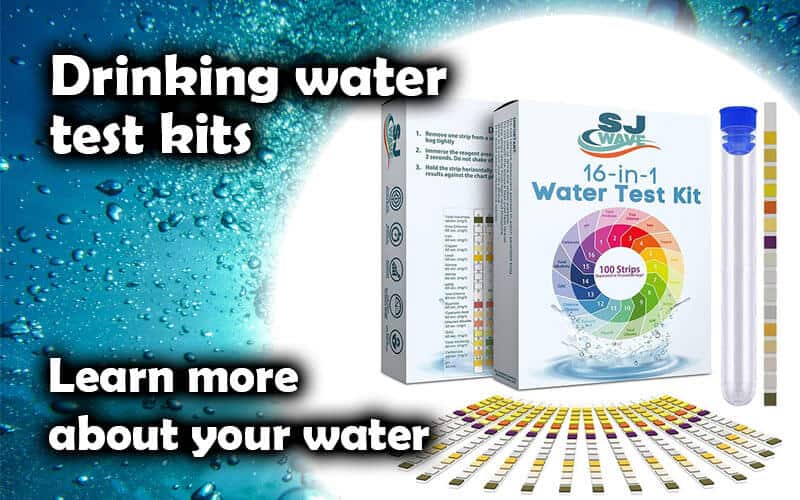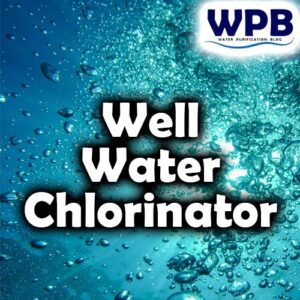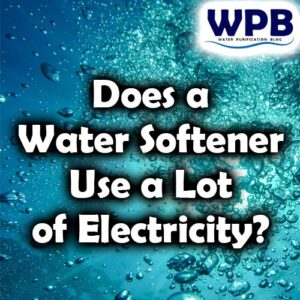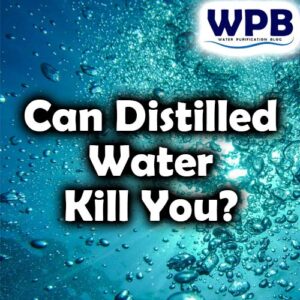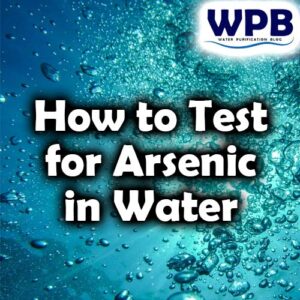What is a 16 in 1 drinking water test kit?
16 in 1 drinking water test kit is an easy way to find out about your water’s quality.
Water test kit will not give You an exact value for the measurement, but it can give you a good and fast estimation and indication about your drinking water quality overview.
By using test strips and submerge a test strip into a water sample, you get the results in only a few minutes.
With a 16 in 1 drinking water test kit, besides tap water quality, you can also control the operation of your water softener or the operation of reverse osmosis systems for water purification.
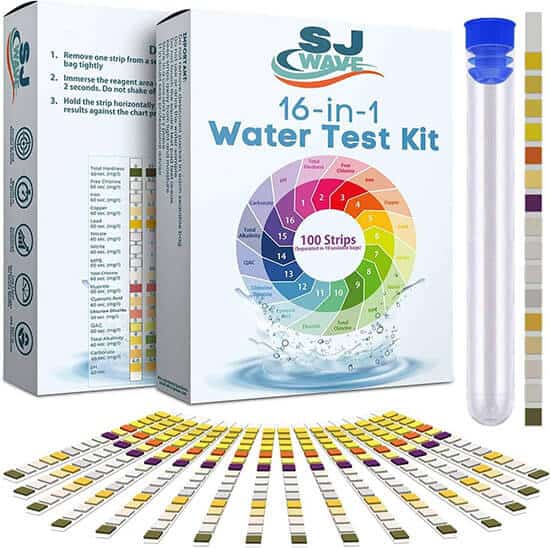
What kinds of water test kit are available?
There are different types of water test kits. Some water test kits are for determining a value for one single element and some are universal for testing up to 16 elements.
Some water test kits are specialized like Aquarium Test Kits or Swimming Pool Test Strips.
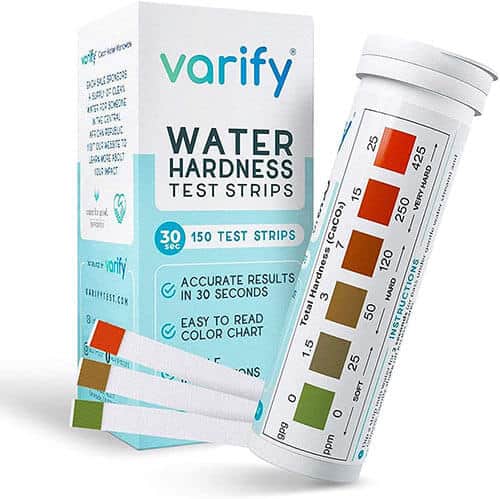
Water Hardness Test Kit – Fast and Accurate Cost Effective Water Hardness Test Strips
Save time and get accurate water test results within seconds. Simply take one of the provided test strips and dip the test strip into the water. Compare the test strip colors with the large color chart on the bottle. This is your water hardness result.
No need to visit a store or wait for someone else to test the quality of your water.
Enjoy consistently accurate and reliable results whenever you need them.
Ideal for you water softener operation control.
16 in 1 drinking water test kit – what can it measure?
With 16 in 1 drinking water test kit You can do a home water quality test for all the following elements:
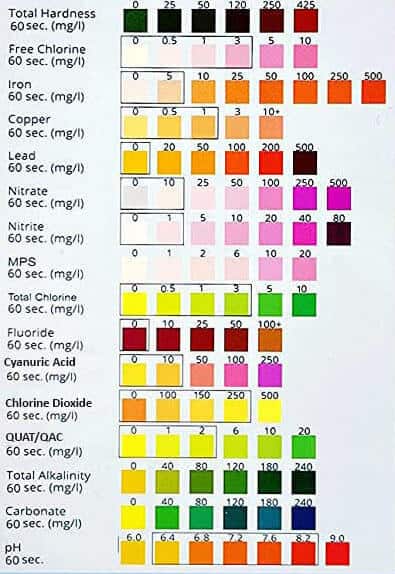

16 in 1 Drinking Water Test Kit – Home Water Purity Test Strips for Aquarium, Pool, Well & Tap Water
- COMPLETE DRINKING WATER TEST KIT – Everything you need to test your water; tests for 16 parameters, ensures lead free and pH safe drinking water; testing tube and dropper included in every kit for easy sample collection
- SEPARATE PACKAGE – 100 testing strips packed in 10 sealable bags with dry agent to ensure long shelf life and reliable results. Strips in an open package need to be used within 90 days while in an unopened package can last up to two years. You don’t need to rush using all 100 strips within 90 days because we bag our strips separately.
- MULTIPLE USES – Test every water source around your home, including drinking, well and tap water, pool & spa, hot tub and aquarium
- RELIABLE AND FAST RESULTS – CE certified for proven, reliable and quick results in 2 minutes – easy to use and great for school projects
- ENJOY THE PEACE OF MIND – Detects low levels of impurities and foreign substances and keeps your family safe
Total Hardness
Easy and fast way to determine if you need a water softener in your home to prevent all limescale problems. With a water test kit you can easily measure your water hardness levels.
Free Chlorine
Chlorine is used to keep the water supply microbiologically safe. Sometimes it can be over chlorinated. Control free chlorine levels easily with the test kit and decide if you need an activated carbon filter.
Iron
Iron is a naturally occurring element that can be found in water sources. It is an essential nutrient for the human body and is necessary for the production of red blood cells and the transport of oxygen in the body.
However, high levels of iron in water can cause it to taste and smell unpleasant and can also cause staining of laundry and household fixtures. It is important to ensure that the levels of iron in drinking water are within safe limits.
Iron can enter water through the corrosion of iron pipes or from the leaching of iron from other sources, such as iron-based minerals in the soil. Iron can also be found in some types of water treatment chemicals.
The levels of iron in drinking water are regulated by the EPA to ensure the safety of the public.
You can easily check your iron levels with the 16 in 1 water test kit.
Copper
Copper is a naturally occurring element that can be found in water sources. It is an essential nutrient for the human body and is necessary for the proper function of red blood cells, the immune system, and the production of collagen.
However, high levels of copper in water can be harmful and can cause gastrointestinal problems, liver damage, and other health issues. It is important to ensure that the levels of copper in water are within safe limits.
Copper can enter water through the corrosion of copper pipes or from the leaching of copper from other sources, such as brass fittings or copper-based pesticides. Copper can also be found in some types of water treatment chemicals. The levels of copper in drinking water are regulated by the EPA to ensure the safety of the public.
Lead
Lead is a naturally occurring element that can be harmful to human health if ingested. It can enter drinking water through the corrosion of lead pipes or from the leaching of lead from other sources, such as lead-based paints or lead-based solder used in plumbing.
Lead can cause serious health problems, especially in young children and pregnant women, as it can damage the brain and nervous system and cause developmental delays and other health issues.
The levels of lead in drinking water are regulated by the EPA to ensure the safety of the public. It is important to regularly test for lead in drinking water and to take steps to reduce lead exposure, such as using a water filter that is certified to remove lead or replacing lead pipes.
Nitrate
Nitrate is a chemical compound that can be found in natural sources, such as soil and water, and can also be introduced into the environment through the use of fertilizers, sewage, and industrial activities.
Nitrate can enter drinking water through the leaching of nitrate-rich fertilizers or sewage into water sources or through the release of nitrate-containing pollutants into the air, which can then be deposited in water sources through rain or snow.
Nitrate in drinking water is a concern because it can be harmful to human health, especially in young children and pregnant women.
High levels of nitrate in drinking water can cause a condition called methemoglobinemia, which reduces the body’s ability to carry oxygen to the tissues.
The levels of nitrate in water are regulated by the EPA to ensure the safety of the public. It is important to regularly test for nitrate in water and to take steps to reduce nitrate exposure, such as using a water filter that is certified to remove nitrates or reducing the use of fertilizers in areas near water sources.
Nitrite
Nitrite is a chemical compound that is formed from the breakdown of nitrate in water or soil. It is also produced by the action of certain bacteria on nitrogen-containing compounds.
Nitrite can enter drinking water through the leaching of nitrite-rich fertilizers or sewage into water sources or through the release of nitrite-containing pollutants into the air, which can then be deposited in water sources through rain or snow.
Nitrite in water is a concern because it can be harmful to human health, especially in young children and pregnant women. High levels of nitrite in water can cause a condition called methemoglobinemia, which reduces the body’s ability to carry oxygen to the tissues.
The levels of nitrite in drinking water are regulated by the EPA to ensure the safety of the public. It is important to regularly test for nitrite in drinking water and to take steps to reduce nitrite exposure, such as using a water filter that is certified to remove nitrites or reducing the use of fertilizers in areas near water sources.
MPS
MPS (methylisothiazolinone) is a chemical compound that is used as a biocide and preservative in a variety of products, including personal care products, cleaning products, and industrial products.
MPS has been found to be toxic to aquatic life and can potentially be harmful to human health if ingested. There is limited information available on the effects of MPS in drinking water, but it is generally considered to be a low risk to human health.
However, it is important to ensure that the levels of MPS in drinking water are within safe limits. The levels of MPS in drinking water are not currently regulated by the EPA in the United States.
However, MPS is regulated by other agencies and organizations to ensure the safety of the public. It is important to regularly test for MPS in drinking water and to take steps to reduce MPS exposure, such as using a water filter that is certified to remove MPS or using products that do not contain MPS.

16 in 1 Drinking Water Test Kit – Home Water Purity Test Strips for Aquarium, Pool, Well & Tap Water
- COMPLETE DRINKING WATER TEST KIT – Everything you need to test your water; tests for 16 parameters, ensures lead free and pH safe drinking water; testing tube and dropper included in every kit for easy sample collection
- SEPARATE PACKAGE – 100 testing strips packed in 10 sealable bags with dry agent to ensure long shelf life and reliable results. Strips in an open package need to be used within 90 days while in an unopened package can last up to two years. You don’t need to rush using all 100 strips within 90 days because we bag our strips separately.
- MULTIPLE USES – Test every water source around your home, including drinking, well and tap water, pool & spa, hot tub and aquarium
- RELIABLE AND FAST RESULTS – CE certified for proven, reliable and quick results in 2 minutes – easy to use and great for school projects
- ENJOY THE PEACE OF MIND – Detects low levels of impurities and foreign substances and keeps your family safe
Total Chlorine
Chlorine is used to keep the water supply microbiologically safe. Sometimes it can be over chlorinated. Control your total chlorine levels easily with a drinking water test kit and find out if you need an activated carbon filter.
Fluoride
Fluoride is a chemical element that occurs naturally in water and certain minerals. It is found in small amounts in the earth’s crust and is released into the environment through the weathering of rocks and minerals. Fluoride is also produced artificially and added to some public water supplies as a means of preventing tooth decay.
Fluoride works by strengthening the tooth enamel, making it more resistant to acid attacks from bacteria that can cause cavities. When people consume fluoride, it is absorbed into their teeth and becomes incorporated into the tooth enamel. Fluoride can also help to repair the early stages of tooth decay, which is why it is often added to toothpaste and mouthwash.
The addition of fluoride to public water supplies is a controversial issue, with some people claiming that it is necessary for good oral health, while others argue that it can have negative health effects. The U.S. Centers for Disease Control and Prevention (CDC) and the World Health Organization (WHO) both support the use of fluoride in drinking water as a safe and effective way to prevent tooth decay.
The optimal concentration of fluoride in drinking water is 0.7 milligrams per liter (mg/L). This concentration has been shown to reduce tooth decay by about 25% in children and adults. Water that contains more than 2.0 mg/L of fluoride is considered to be high in fluoride and can cause dental fluorosis, a condition that can cause white spots or streaks on the teeth.
In the United States, the Environmental Protection Agency regulates the amount of fluoride that can be added to public water supplies. The EPA has set a maximum allowable concentration of fluoride in drinking water at 4.0 mg/L to protect against the risk of dental fluorosis.
If you are concerned about the fluoride content of your drinking water, you can check with your local water utility or refer to the EPA’s website for more information. You can also use a home water test kit to measure the fluoride concentration in your water. If you live in an area where the fluoride content of the water is high, you may want to consider using an alternative water source or a water filtration system that is designed to remove fluoride.
You can check fluoride levels in water very easily with a drinking water test kit.
Cyanuric Acid
Cyanuric acid is a chemical compound that is sometimes used as a disinfectant in swimming pools and hot tubs. It helps to maintain the effectiveness of chlorine as a disinfectant by slowing down the rate at which it is broken down by sunlight.
In drinking water, cyanuric acid is not used as a disinfectant. Instead, it is sometimes found as a byproduct of the water treatment process or as a result of the use of certain types of water treatment chemicals. It is also possible for cyanuric acid to be present in drinking water as a result of agricultural or industrial activities.
The presence of cyanuric acid in drinking water is not necessarily a cause for concern. However, high levels of cyanuric acid can interfere with the effectiveness of chlorine as a disinfectant and may also cause a buildup of trihalomethanes (THMs), which are potentially carcinogenic chemicals that can form when chlorine reacts with organic matter in water.
If you are concerned about the presence of cyanuric acid in your drinking water, you should contact your local water utility or a certified water testing laboratory to have your water tested. They will be able to provide you with information about the levels of cyanuric acid in your water and advise you on any necessary steps to address any issues.
Chlorine dioxide
Chlorine dioxide is used as an alternative to chlorine for water disinfection. Higher levels of chlorine dioxide are not recommended. You can easily test the water for chlorine dioxide content with a drinking water test kit.
QAC
Quaternary ammonium compounds (QACs) are a group of chemicals that are sometimes used as disinfectants in water treatment. They are also known as “quats.” QACs are effective at killing a wide range of microorganisms, including bacteria, viruses, and fungi.
In drinking water, QACs are not commonly used as a primary disinfectant. However, they may be used as a secondary disinfectant to help maintain the quality of water in distribution systems and to prevent the growth of bacteria in storage tanks.
It is possible for QACs to be present in drinking water as a result of their use in water treatment or as a result of agricultural or industrial activities. The presence of QACs in drinking water is generally not considered a health concern, as the levels of QACs that are typically found in drinking water are generally low.
If you are concerned about the presence of QACs in your drinking water, you should contact your local water utility or a certified water testing laboratory to have your water tested. They will be able to provide you with information about the levels of QACs in your water and advise you on any necessary steps to address any issues.
Total Alkalinity
Total alkalinity is a measure of the capacity of water to neutralize acids. It is expressed in milligrams per liter (mg/L) or parts per million (ppm). Total alkalinity is important in water treatment because it helps to maintain a stable pH in the water, which is important for the effectiveness of disinfectants such as chlorine.
In drinking water, total alkalinity is typically measured as part of a routine water quality analysis. It is generally not a concern if the total alkalinity of drinking water falls within the range of 50-150 mg/L or ppm. However, water with very high total alkalinity may taste and smell unpleasant, and it may also cause problems with the corrosion of pipes and other plumbing fixtures.
If you are concerned about the total alkalinity of your drinking water, you should contact your local water utility or a certified water testing laboratory to have your water tested. They will be able to provide you with information about the total alkalinity of your water and advise you on any necessary steps to address any issues.
Carbonate
Carbonate is a chemical compound that is formed when carbon dioxide reacts with water. In drinking water, carbonate can be present as a result of natural processes, such as the decomposition of organic matter in the water, or as a result of the water treatment process.
Carbonate can have an impact on the pH and alkalinity of drinking water. Water with high levels of carbonate may have a high pH and total alkalinity. This can be a concern because water with a high pH may taste and smell unpleasant, and it may also cause problems with the corrosion of pipes and other plumbing fixtures.
If you are concerned about the presence of carbonate in your drinking water, you should contact your local water utility or a certified water testing laboratory to have your water tested. They will be able to provide you with information about the levels of carbonate in your water and advise you on any necessary steps to address any issues.
pH value
pH is a measure of the acidity or alkalinity of a substance. It is measured on a scale from 0 to 14, with 7 being neutral. A pH less than 7 is considered acidic, and a pH greater than 7 is considered basic or alkaline.
The pH of drinking water is important because it can affect the taste, smell, and appearance of the water, as well as the solubility and stability of other substances in the water. It can also affect the effectiveness of disinfectants such as chlorine and the corrosion of pipes and other plumbing fixtures.
In general, it is recommended that the pH of drinking water be between 6.5 and 8.5. Water with a pH outside of this range may taste and smell unpleasant and may also be more corrosive to pipes and other plumbing fixtures.
If you are concerned about the pH of your water, you should contact your local water utility or a certified water testing laboratory to have your water tested. They will be able to provide you with information about the pH of your water and advise you on any necessary steps to address any issues.
The easy way to know your water’s pH value is with a drinking water test kit. You can do it at your home without expensive laboratory water testing.
Conclusion
16 in 1 drinking water test kit is an essential tool especially as at home test kits for ensuring that the water you use is safe and healthy.
Drinking water test kit is easy to use, ideal for testing tap water and can help identify potential contaminants and take the necessary steps to improve drinking water quality.
By regularly using a drinking water test kit and testing the quality of your water, you can protect yourself and your family from the negative effects of contaminated water.

Who am I?
I am working as a water treatment technical manager and I have more than 25 years of practical experience in water purification.
Water purification expert
After many years of experience in water purification, I want to share some of my knowledge and get people to know the real importance of water quality.
Water purification and water treatment are very complex themes, so it is important to explain them in an easy-to-read way.
On this blog, you will find many understandable, easy-to-read information about water purification.
I hope you enjoy it, find some useful information, and thank You for reading.
More info on my work and my expertise on water purification can be found on my LinkedIn profile.

